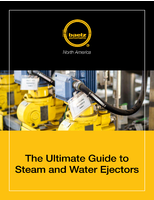Briquetter squeezes chips into briquettes.
Press Release Summary:

FastPac(TM) transforms mounds of metalworking chips, strings, and nests; fines; and sludge into dense, dry, and compact briquettes. Featuring dual-stage compacting process and dual-action compression/ejection cycle, machine handles 110-6,614 lb of metal chips and swarf per hour. Materials from single machines, cell, system, or entire facility may be processed. It provides 6-8 times reduction conversion and squeeze-dries chips to remove up to 98% of residual coolant and cutting oil.
Original Press Release:
Squeezing Chips into Briquettes
At IMTS 2004, Mayfran International's exhibit included the Mayfran® FastPac(TM) Briquetter, which transforms mounds of metalworking chips, strings and nests, fines and sludge into dense, dry and compact briquettes. The FastPac series of briquetting machines, (made exclusively for Mayfran by RUF GmbH & Co. KG) can offer an investment payback in one year or less by increasing the values of ferrous and nonferrous chips and scrap while lowering costs and frequency of removal. Transport spill liability risks are reduced by increasing the amount of coolant and cutting fluids reclaimed. It also reduces the need for large scrap storage areas and helps users keep better track of scrap volumes and weights while providing a cleaner, safer, more efficient work environment. FastPac's dual-stage compacting process and dual-action compression/ejection cycle requires less horsepower than other types of compactors, thus lowering energy consumption and operating costs. In addition, FastPac's compact design results in a space-saving footprint of the machine. All briquetters are tested for extended periods at the factory prior to delivery so installation usually requires little more than an electrical connection.
FastPac Briquetting systems have very low energy consumption with capacity ranges of 110 lb. all the way up to 6,614 lb. (50 kg. to 3000 kg.) of metal chips and swarf per hour. Materials, including steels, cast iron, aluminum, copper and other alloys, from a single machine, a cell, system, or an entire machining facility may be processed. The system provides an approximate 6 to 8 times reduction conversion. For example, 6 to 8, 55 gallon barrels of chips will compress to one barrel of briquettes. Just as important, during the compression operation, the FastPac system will "squeeze dry" the chips, removing up to 98% of the residual coolant and cutting oils. The excess fluid drains from the compression chamber and is collected in a tray below making it available for immediate reuse or further reclamation processing. This drying process not only allows the recovery of additional, and valuable oils and coolants, it also provides added protection against high environmental clean up costs and potential fines in the event of a spill, either during transport or while in storage.
Except for keeping its load hopper full (which can be automated), FastPac performs virtually unattended. A screw drive feeds the chips, strings and shavings from the hopper to the first compacting stage-- a pre-charge chamber that helps assure consistent chip volume. Maximum density will be achieved during the second, briquetting compression stage. The screw drive's running time is programmed and monitored by a PLC control unit. The running time can be modified to optimize the pre-charge load, depending upon types of chips and materials being processed.
When the pre-charge chamber is loaded, a secondary piston is activated to provide preliminary compression. This load is then transferred to one of two compression die chambers where the system's main compression piston transforms the pre-compressed material into a dense briquette. Simultaneous with the forward movement of the primary piston during the compression process, a briquette located in the opposite die chamber and formed during the preceding cycle, is ejected through an offload opening to a chute. As the primary piston retracts, the die chambers slide to reposition the just emptied chamber for the next compression cycle. With the completed briquette in the second chamber set in position for ejection the primary piston retracts, the die chambers slide to reposition the just emptied chamber for the next compression cycle. A ramp at the machine's discharge elevates briquettes to heights that will clear virtually all containers or roll-off bins eliminating the need for expensive elevation equipment. Meanwhile, the screw feed and pre-charger have already begun their steps of loading and pre-compression for the next cycle. This dual-stage, dual-action operation means a briquette is formed with every machine cycle, unlike other systems that typically require multiple strokes. This results in the FastPac systems' ability to maximize output capacity while minimizing horsepower requirements and energy consumption.
Also shown by Mayfran at IMTS were a ConSep® 1000 with a Mayfran AT(TM) Cleaner for grinding applications, the new CrosBelt(TM) FS 2000 chip removal/coolant cleaning separator unit with an AT Cleaner, a CT 20 ChipTote®, a magnetic roller conveyor, a VBU300 Chip Wringer and single shaft MA Shredder...integral elements of a Mayfran Viavent® overhead, centralized multi-machine chip and coolant pumping system.
For additional information regarding Mayfran International and its products, visit www.mayfran.com.




